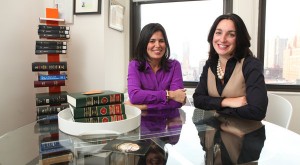 Gabay & Bowler were featured in the Business Section of The New York Times in the article, Skipping the Legal Partner Track for a Shingle of One’s Own. November 23, 2011
Gabay & Bowler were featured in the Business Section of The New York Times in the article, Skipping the Legal Partner Track for a Shingle of One’s Own. November 23, 2011
Five and a half years ago, after spending years as commercial litigation lawyers at Proskauer Rose in New York City, Sari Gabay-Rafiy and Anne Marie Bowler decided to strike out on their own. They started Gabay-Rafiy & Bowler more as a lifestyle choice than a money-making venture. The first year in business, Ms. Gabay-Rafiy said, she made “just enough to pay the babysitter.”
Over time, Ms. Gabay-Rafiy and Ms. Bowler learned to re-evaluate their business practices continually to assess what was useful and profitable. That led to their decision in 2009 to move to smaller office space and to discontinue storing files offsite. Moving cut their rent 35 percent (they sublet two offices in the new space to nonlawyers) and storing files onsite saved them about $300 a month.
They run a lean operation — just the two of them and one assistant — and they rely on their connections to an informal network of lawyers for everything from expert advice to case referrals. They sent announcements to every lawyer they knew when they left Proskauer, and they exchange business cards everywhere they go: seminars, continuing education courses, cocktail parties, networking events, even elementary school drop-offs.
Today, despite the recession, the firm is thriving. The partners say they have exceeded what they were earning when they left Proskauer. And they are part of what appears to be a trend of lawyers in their mid-20s to early 40s leaving large firms to start their own small ones.
Statistics are not easy to come by, but Margie R. Grossberg, a partner at the legal recruiting firm Major, Lindsey & Africa, said she saw an increasing number of associates choosing entrepreneurship. “In the past, associates found if they worked really hard and did the right things, they made partner,” she said. “That’s not necessarily the case anymore. The odds are a lot slimmer, and it’s also not as coveted as it once was.” These lawyers want more control over their futures, Ms. Grossberg said, and they do not want to wait until they become partner to have meaningful relationships with clients.
The economy is another factor. “There have been thousands of associates laid off because of the recession,” said Eric A. Seeger, a principal at Altman Weil, a legal consultancy. “We’re seeing more lawyers out there now taking risks, and that includes going out on their own.”
Starting a law firm presents many challenges, especially for associates who have not had much experience running a firm. Michael Yim, Jane Chuang and a third lawyer, all former law school classmates, decided to start a firm in Manhattan last year, taking one large client with them. Three months later that client dropped them, taking 75 percent of the fledging firm’s revenue. Mr. Yim and Ms. Chuang’s third partner could not stomach the loss, and the relationship among the three became tense. He soon left, but Mr. Yim and Ms. Chuang soldiered on. “We started from scratch again, taking a long-term view of profit generation,” Mr. Yim said.
The firm became Yim & Chuang and now, a year later, business is better than Mr. Yim had projected, although marketing has been difficult. “There aren’t a lot of people who know about us yet,” he said. Still, he and Ms. Chuang decided not to take work they could not handle or simply did not want, even when it was tempting. “You can get this sense of desperation where you’ll take any paying client that walks through the door,” Mr. Yim said. “We’ve learned the best clients are people we would socialize with, because the relationship is comfortable, there is trust and it’s far more productive.”
In 2007 Joel Kauth and two of his colleagues left Christie Parker Hale in Irvine, Calif., to start Kauth, Pomeroy, Peck & Bailey with Kent Pomeroy, a lawyer and accountant. Mr. Kauth and his former Christie colleagues did not like the traditional billable-hours structure, so they decided to give clients a flat rate for services. “Clients love us because we give them predictability,” Mr. Kauth said. “It’s not some billable black hole.”
The billing system has been profitable for the firm because its partners have enough experience to estimate their time, and they give specific prices for particular tasks. Still, once in a while, Mr. Kauth said, “if the court is being difficult or opposing counsel is crazy, the cost goes up and we just have to eat it.”
The firm bills up front when the costs for third-party services like document production or expert witnesses is high. “Large firms have an infrastructure in place that can absorb big purchases for a large case,” Mr. Kauth said. “When you’ve got three or four people, it’s much tougher. I can’t front $300,000 on a project.” Clients are generally understanding, he said, and the firm gives them the vendor’s bill, so they see there is no markup.